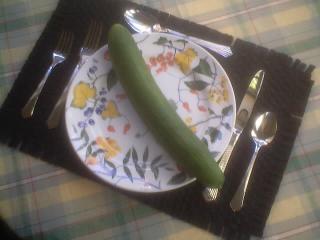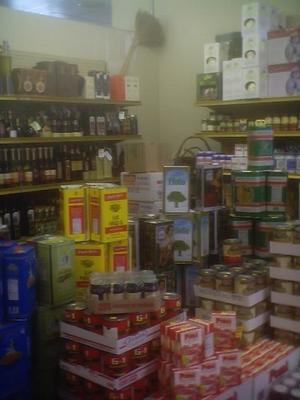
Ingredient Sleuth's First Anniversary -- Let Us Eat Cake!

Great ingredients are available in mainstream grocery stores, at outdoor markets, at specialty stores, around the world or around the next corner. Add to the thrill of the find by using the ingredients to pep up a tired recipe -- or to create a whole new dish and name it after yourself! All it takes is keeping one's eyes open and one's taste buds in gear! When it comes to searching out those great ingredients, the Ingredient Sleuth is on the case!
I have enjoyed this year of Ingredient Sleuth blogging so very much!
Many thanks and Happy Thanksgiving to all!
Bon Appetit!



Wouldn’t it be nice to just be able to pick up a pencil and draw a pretty picture of whatever inspires you at the moment? Or to come rushing home from the arts-and-crafts store with a bright new selection of “colors” and set to work in a bright, north window?
Or maybe even better – to be able to get out a pen and draw feverishly in squared-off boxes to commit to a cartoon strip those pithy comments that come to mind (usually ten to fifteen minutes AFTER the perfect opportunity to say them has passed)? If I could draw (which, sadly, I can’t!), I would accompany this writing with step-by-step drawings.
Beautiful as artichokes are, they require a fair bit of instruction, not only as relates to their cooking, but also to their pre-cooking preparation and their eating as well. Like many complicated things though, they are well worth the effort!
Just like the people who eat them, artichokes come in various sizes. The small, “baby” size weighs only about 2 ounces each and are typically only an inch or so in length, tip to bottom. They grow at the base of the artichoke plant (which is a thistle like plant, though actually a member of the daisy family, whose “flower” buds are the artichokes). They are so tender and tiny that there is no fibrous (some, including the Ingredient Sleuth would say “stringy”) choke in the middle.
Moving upward, on the plant and in size, medium artichokes weigh in at 5 to 8 ounces each and come from the side branches. These are the artichokes that we will discuss, and refer to, as the “dippables”!
Large artichokes may weigh a pound or more, grow on the center stalk of the plant and are usually eaten stuffed – a bit tricky and tedious, prep-wise -- with a savory filling.
Buying tips:
- Compact and heavy for its size
- Leaves that are fleshy, thick, firm, tightly closed
- Stem end firm, no tiny holes which would indicate worm damage
- Spring artichokes soft green in color
- Fall and winter artichokes olive green, possibly bronze-tipped leaves
- Avoid blackened, wilted, bruised leaves
- Squeeze it! Plump and crisp leaves make a squeaky sound! (Beware the vegetable police during this step!)
Storage:
- Refrigerate, in a plastic bag, 4 to 5 days maximum.
- Do not wash before storing; sprinkle a few drops of water into the bag, then close.
Preparation for the “dippables”:
- Wash under cold running water
- Cut off the top inch of the artichoke with a large, sharp knife
- Optionally: clip the sharp tips of the leaves with a kitchen shears
- Optionally: prevent darkening by rubbing the cut parts with lemon juice
- Cut off the stem flush with the base to create a flat surface
- Pull of any remaining short, coarse leaves from the bottom
Cooking of the “dippables”:
- Place artichokes on their flat bases, side by side, in a large, non-reactive pot in which water is already boiling (careful for splashes!), water depth about half that of the artichokes.
- Add a couple tablespoons of lemon juice or vinegar to retain color and brighten flavor.
- Cover the pot and return the water to a boil, then reduce heat to medium-low.
- Lift the lid a few times during cooking to help with color retention (this is an EASY instruction to follow for Type A personalities, take it from me!).
- Cooking time is 20 to 40 minutes, depending upon size. They are done when an inner leaf can be pulled out easily (with tongs, not tender fingertips!).
- Invert the artichokes in a colander so that the water drains from between the leaves.
Eating (AT LAST!) of the “dippables”:
- RELAX! Really! This is an important first step. Artichokes were not meant for gobbling! They are very rich, meant to be savored and deserve to be treated as, well – a TREAT! It doesn’t matter if they “cool off” and, in fact, slightly warm to room temperature is just right to detect the full flavors.
- There it is! A lovely, whole, glistening artichoke, on its plate, in front of you – and it’s ALL for you – the whole thing!
- Pull off a leaf and dip its fleshy base into your sauce of choice.
- Place the bottom half of the leaf, curved side down, in your mouth and draw it between your teeth so that you scrape off the tender flesh from the inside of the leaf.
- Optionally: say “Mmmm” quietly -- or shout it!
- Repeat this process for all those lovely, fleshy leaves. Maybe you’ll enjoy making an artistic little arrangement of the “used” leaves on your plate!
- When you get to the inner petals – these are thin (like flower petals), rose colored, and bunched to a point at the top – you can bite off the bases rather than scrape them through your teeth.
- Underneath the petals is the choke – that tuft of slender hay-colored fibers resembling cornsilk (but very, very, choke-y if they get into your mouth!!! Time to be careful, once again).
- Pull (or scrape) off all of the choke fibers to expose the artichoke bottom – it resembles the center of a daisy.
- The artichoke bottom is dense, creamy, velvety and – hooray – COMPLETELY edible. It can be cut into quarters and then dipped – aw, go ahead, let’s “bathe” not just “dip” these pieces! They are the true finale – the “big finish” -- of the artichoke experience!
Dipping Sauces to Try (just a few suggestions):
- Butter: the classic dip for artichokes
- Hollandaise sauce: you know the one, that rich egg-yolk-and-butter cooked sauce
- Plain oil-and-vinegar salad dressing
- Japanese-style sauce of soy sauce, lemon juice, garlic, ginger, dark sesame oil
- Plain yogurt flavored with garlic, lemon juice and prepared mustard
- Roasted red peppers pureed with a little extra-virgin olive oil
- Tomato sauce, fresh or cooked
- Roasted garlic cloves pureed with a little extra-virgin olive oil and lemon juice
Because the medium-sized, dippable, artichokes are such an event unto themselves, they are often served as a separate, first course. That way, they get the attention they deserve and their unique, subtle flavor is not camouflaged with other foods. And, undoubtedly, they alone are enough to keep even we two-fisted eaters completely engaged!
While it is slightly unfortunate that I could not draw instructional pictures – of course, artichokes aren’t really all that difficult after all, now are they – I still wish that I could grab hold of some trusty paints and sketch out a lovely artichoke still-life. With their dramatically sculpted shapes, they are individual masterpieces of design and structure -- truly artful subjects for a painting indeed.
Maybe if I painted quickly enough and the artichokes were still fresh when the painting was complete, I could then cook them up and eat them. Enjoy their wonderful flavors -- yet still see them in their integral beauty in the painting. Rather like “having your artichoke and eating it too,” I suppose!
Bon appetit!
You just never know what you are going to see when you visit Paris! Sometimes I think that I should attempt to stay awake 24 hours a day, just so that I don’t miss anything, when I am there!
Maybe that’s not such a strange idea, in fact. Once a year, the City of Light celebrates “La Nuit Blanche” or “The White Night” in which major monuments, museums and shops remain open throughout the night and performances are presented on outdoor stages across the city. This year’s event, on October 1st, attracted about 1.3 million visitors – and the Ingredient Sleuth was one of them!
But, even without all-night events, there is SO much to be discovered in Paris! For example, when was the last time that you saw someone directing a symphony orchestra – or traffic -- with a baguette? Or scooping up a steamy, Chinese dinner with two baguettes? Or poking a slow-to-start fire with a baguette?
The French word baguette, as you may suspect, refers to much more than bread. It is also used to portray a musical conductor’s (or police officer’s) baton, chopsticks, or just a plain-old, generic stick. A baguette magique is a magic wand, a baguette de tambour is a drumstick.
In the hands of French bakers (boulangers), a baguette is a defining element. Texture, aroma, flavor and characteristic sticklike shape combine to present the quintessential French bread. What fun to emerge from the bakery, baguette in hand and saunter down the street, mouth watering in anticipation. Sometimes, the aroma is overpowering and a few delicate nibbles are required, en route!
The quality of a baker’s baguettes, in fact, has traditionally been a source of great pride in France. Never mind the dozens of other varieties of bread that glisten, steam and gleam tantalizingly, lined up in shop windows. Healthy whole grains, seeded rolls, coarsely-sea-salted rounds … the list is never-ending and ever-changing. Nonetheless, the baguette remains the boulanger’s defining product.
After the French Revolution (1789), the baguette came to serve as a symbol of the right of every French citizen to nourishment at a fair price. The legitimacy of a government, then as now, sprang from having sufficient quantities of nourishment available to citizens at affordable prices. For a time, the price that a French baker could charge for a baguette was government-controlled. Bread, after all, was the staff of life during this period in Europe.
The method used to bake baguettes during the 18th century featured an overnight development of the yeast, resulting in a baguette with a cream-colored interior (rather than white) and a much more pronounced flavor and aroma than other breads. Over the decades and centuries, speeded along by “modern” mechanized methods, shortcuts inevitably ensued and the character of the average baguette changed. A general decline of baguette quality, beginning with the 1950s, is documented by Steven Kaplan, in his book THE BEST BREAD IN THE WORLD: THE BAKERS OF PARIS IN THE 18TH CENTURY (LE MEILLEUR PAIN DU MONDE: LES BOULANGERS DE PARIS AU XVIIIe SIECLE), Fayard Publishing, 1996).
In a second book on the subject, THE RETURN OF GOOD BREAD, published in 2002, Mr. Kaplan (an American, a French cultural historian and a visiting professor at the University of Pennsylvania who teaches European history at Cornell University) describes the movement by a new generation of French bakers, in the 1990s, to return to slow-fermentation processes. He visited some 600 bakeries in Paris (this sounds like a lot of fun to me!) as part of his research, tasted their baguettes and sometimes got wrist-deep into the dough in his search for understanding! This book, like the first, was well-received by the French bakery establishment.
In an additional book, Mr. Kaplan rated baguettes of the individual bakeries of Paris. While academically interesting and astonishingly impressive in its detail, this “guide book to the baguettes of Paris” comes best into focus and is most valuable, I think, when used to heighten the awareness – and expectations -- of the consumer.
Recently in fact, the French government codified into law a specific type of baguette (the baguette de tradition) that can only be made using the original, pre-modern methods. This classification definition resulted to a great extent from the detailed work done by Mr. Kaplan.
And what about the rest of us – those of us who buy baguettes in other parts of the world? Well, good bread baking, like news these days, travels very fast! Bakers near and far apply traditional techniques and offer their breads for sale. Specialty areas of supermarkets feature niche-bakery products. Artisan bakers show up at farmers’ markets and offer baguettes baked that morning. Vietnamese bakers (especially predominant here in southern California), turn out baguettes using techniques taught to their ancestors by the French during the colonial period.
One of my friends, who like Mr. Kaplan is a university professor (although of communications rather than European history), knows how to turn a baguette into a very tasty treat. Genelle is an adventurous eater and an excellent cook who, with her husband Doug (contributor of the Cilantro-Lime Chicken recipe from the Ingredient Sleuth’s “Coconut Connection” posting of 04/22/05), particularly enjoys whipping up delicious dishes from on-hand items.
The following recipe for quick and easy crostini ("crostini" means "little toasts" in Italian) sprang from the availability of an “embarrassment of basil and mint” (as Genelle so descriptively phrased it – of course, she IS a professor of communications) in their backyard herb bed:
CROSTINI A LA GENELLE
(Serves 2 to 3 for lunch, more as an appetizer.)
Tomatoes, seeded and chopped into dice to make 1 cup’s worth
Half a sweet onion (like Vidalia or Walla Walla), chopped fine
1/4 to 1/3 cup fresh herbs (cilantro, mint, basil, any combination), chopped
1 to 2 cloves garlic, chopped very fine
1/4 to 1/3 cup balsamic vinegar
1 to 2 tablespoons extra-virgin olive oil, plus additional for brushing on bread
Sea salt and freshly-ground pepper to taste
Parmigiano Reggiano
French baguette
1. Cut the baguette into thin slices. Brush each slice with olive oil and broil 3 to 4 minutes or until toasted. Set aside.
2. Put tomatoes, onion, herbs, garlic, balsamic, olive oil, salt and pepper in a bowl. Mix until combined. With a cheese grater, shred Parmigiano Reggiano over the mixture and blend in to taste. Garnish with more Parmigiano Reggiano and sprigs of the fresh herbs.
3. Serve topping with the broiled bread, providing a spoon for each guest. Guests spoon the tomato mixture onto the bread.
Copyright Note: Recipe reprinted by the Ingredient Sleuth with the permission of the author.
The bright and fresh blend of flavors in the topping of this luscious crostini combines beautifully with the rich-and-crunchy earthiness of the baguette. I think the French bakers would be proud, even though it is an Italian dish! But then, would one expect anything less from a professor with a French-sounding first name who is part Italian (ancestrally-speaking, at least!)?
So, let’s gather 'round the table, pick up our spoons and start scooping. Better yet, why not pop some French tunes by the Baguette Quartette into the CD player? This musical foursome focuses on music that was popular in Paris between 1920 and 1940, including valses musettes, tangos, pasos dobles and fox trots. And just to keep the global aspect of the baguette’s progress in mind, let’s be aware that the Baguette Quartette is from the San Francisco Bay Area!
It really seems that, these days, it’s baguettes, baguettes, everywhere! Bon appetit!





